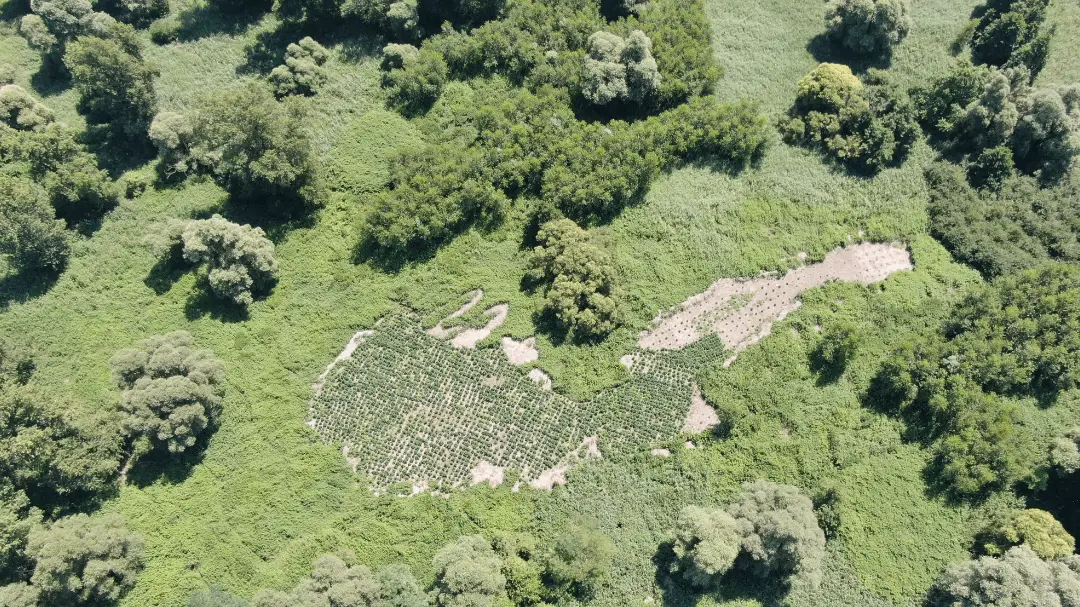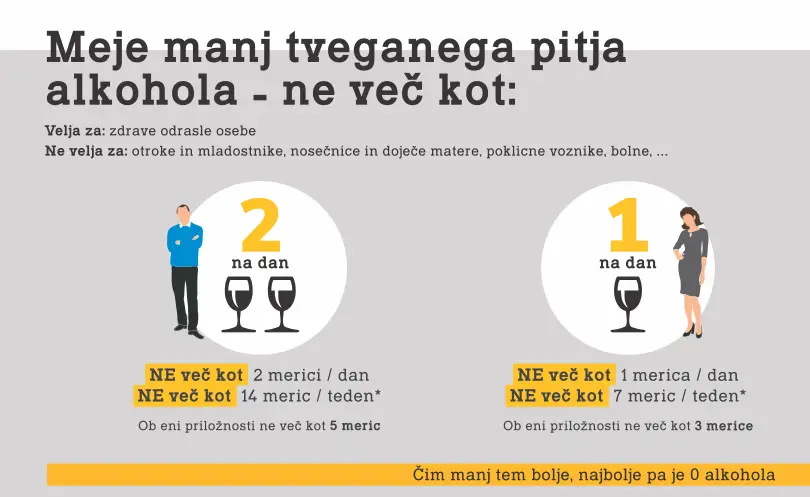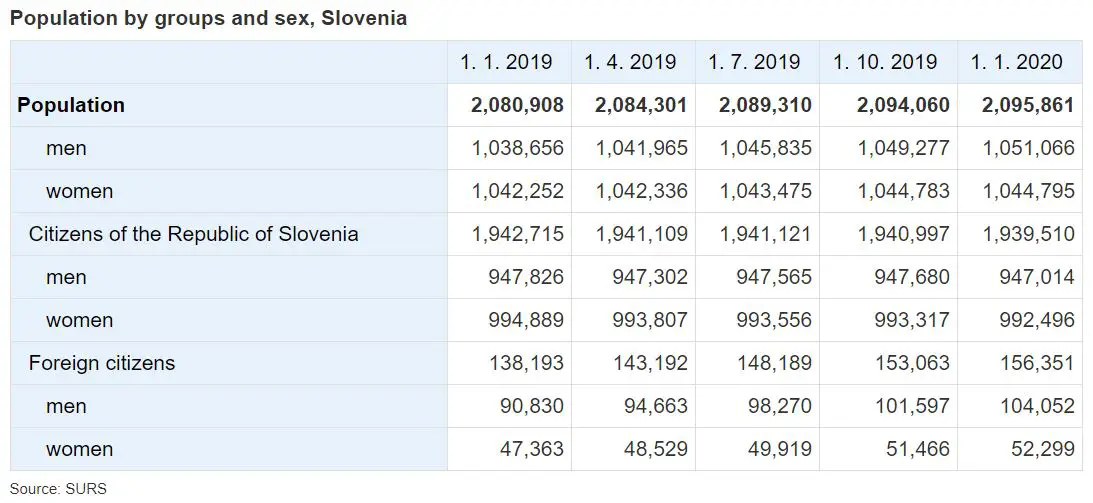Lifestyle
STA, 15 August 2020 - Special masses were held around the country on Saturday to mark the Feast of the Assumption, one of the main Christian holidays and a national holiday in Slovenia since 1992. Marked by coronavirus measures, the ceremonies drew less people than usually, with the main mass attended by some 3,000 believers, 2,000 less than last year.
There are several hundred churches in Slovenia devoted to the Virgin Mary and several of them, mostly older ones, especially to Mary's "assumption of body and soul into heavenly glory".
Slovenian bishops symbolically entrusted the Slovenian nation into Mary's hands in 1992 and that year 15 August also became a bank holiday, marked by pilgrimages.
The main celebration of the Assumption is traditionally held at the Brezje Basilica of Mary Help of Christians (Marija Pomagaj Brezje), one of Slovenia's holiest and most popular pilgrimage sites, where mass was given by Cardinal Franc Rode along with Ljubljana Archbishop Stanislav Zore.
This year marks the 20th anniversary of the naming of Brezje as the Slovenian National Shrine Mary Help of Christians.
Holy masses, mostly delivered by Slovenian bishops, were held today at the majority of the main sites of Marian devotion in the country, including at the Basilica of the Virgin Protectress in the village of Ptujska Gora, another popular pilgrimage site. Maribor Archbishop Alojzij Cvikl gave mass there.
In Kranj, mass was delivered by the titular archbishop of Beneventum and apostolic nuncio to Iraq Mitja Leskovar, while retired Ljubljana Archbishop Anton Stres addressed worshippers at the Church of St Mary at Svete Gore near Bistrica of Sotli.
The ceremonies were adjusted to the epidemiological situation and measures aiming to prevent the spread of the novel coronavirus, with many of the masses, including at Brezje and Ptujska Gora, held outdoors.
The Slovenian Bishops' Conference has called for the observing of instructions issued by Slovenian bishops and in place since 21 July 2020. Priests and worshippers are urged to respect the 1.5-metre gap, disinfect their hands and use protective masks indoors. Traditional processions and fairs held at some locations have been cancelled.
The elderly, people with health conditions and all belonging to risk groups have been invited to attend holy mass in their home parish or tune in via TV, the Bishops' Conference told the STA.
STA, 12 August 2020 - A survey about young people during the epidemic has shown that youths perceived distance learning as less effective than in-class education. More than a quarter were concerned about finishing the year. But the biggest problem for them was the lack of social contacts. Nevertheless, most also see positive sides of the situation.
About 72% of the young included in the survey conducted by the Slovenian Youth Council in May and June assessed that remote learning was less efficient than traditional schooling.
More than half of them believe they did not absorb the knowledge well enough and that they did not receive adequate and clear information.
About 20% of the respondents said they did not have all the required equipment for home schooling. More than a third had problems with internet connection, and more than a quarter expressed concern about whether they will be able to finish the year at all.
Six percent of respondents said that they did not have their own access to fresh air such as a balcony, terrace or a garden during lockdown, while 16% reported not having the necessary peace and quiet in their home when needed.
About 17% of the young included in the survey had to move home from their student dorm because of the epidemic.
As for coping with the absence of public transport, 14% said this had a negative impact on their everyday life because they would need public transport during the epidemic or because they had to help others who would need it. But more than half (53%) said they use public transport regularly but did not needed it during the epidemic.
Almost half of respondents (47%) said their income decreased during the epidemic, and one in four said their income in that period was not enough to cover their basic needs. The Youth Council attributes this drop to a drop in demand for student work.
The feelings of loneliness increased among some young people, with 15% of young women and 7% of young men saying they had nobody to turn to.
About 49% of young women and 36% of young men said they obeyed all rules and recommendations during the epidemic.
As many as 69% of respondents said they missed contacts with other people, especially their friends and relatives.
However, 85% of respondents also detected some positive changes, such as changes to their personal habits, pointing to better hygiene standards and a healthier lifestyle, but also to positive changes related to environment protection, calmer lifestyle, opening hours of shops, more family time, less traffic, changed shopping habits, solidarity, and digitalisation.
STA, 10 August 2020 - Three men from the Maribor area were arrested last week after blackmailing a man with recordings obtained illegally from his home security system, with the police advising the public to be cautious about the security settings of video systems in their homes. "You may find video footage from your home online pretty soon."
A week ago, the victim reported to the police that he had received a letter telling him that defamatory facts would be revealed unless he paid EUR 30,000, Maribor police spokesman Miran Šadl said.
A handover was agreed during which the police arrested a 21-year-old man. The investigators determined that he had been aided by a 22-year-old and a 24-year-old.
They did not acquire the footage from the video system directly but came across it online. The footage was acquired by a third party, who "posted it on a website with such content", the police said.
It warned video surveillance system owners to be cautious when installing such systems, above all they should set secure passwords.
Special caution is required for wireless cameras and systems connected to a network or such that upload footage to a cloud, with the police recommending that the latter be disabled for cameras in private homes.
The police said that the victim was not a public persona, nonetheless the video footage could have damaged his good name and reputation.
The threesome was apprehended and released after the prosecution said there was no grounds to hold them. They will, however, be charged with blackmail, which carries a prison sentence of between a year and seven years.
The 22-year-old was also found with banned sports performance enhancers and the M81 cannon cracker and may face a year to ten in prison for the former and between a year and five years for the latter.
The British International School of Ljubljana have been busy planning for the upcoming academic year and how best to meet the challenges ahead, as well as the needs of all their students when learning commences at the end of August 2020.
A full review of the premises has already been completed, including a deep clean, room layouts altered, and guidance updated to meet health and safety expectations with a variety of new hygiene provisions for everyone in the building. They continue to plan for smaller classes, outside breaks in spacious areas and a restriction of events where students gather. Following these guidelines, keeping the children safe and healthy is their absolute priority and at the heart of everything that they do.
Along with the preparation of the current building, the school is continuing to expand with developments on the new building now fully visible. This exciting project shows the growth and ambition of the school as it heads towards considerable improvements in the pedagogical facilities, as well as increasing the size of the very popular ‘Woodland Area’. This area was used significantly in the last term with students enjoying a range of outdoor learning experiences, exercising in the open space and learning through play and exploration. With specialist classrooms, open performing spaces and the adjoining woodland area, the students are guaranteed to enjoy and benefit from the improvements to the physical school building.
The most exciting area of improvement is with the quality of education to meet the needs of all of the students in the school. During the planning stage for the coming term, the school has invested heavily in online training for teachers with the Orbital Group eLearning Manager, Zsofia Alibaux Jakab, coordinating all online training to enhance and transform student learning through the Orbital online learning platform. Training sessions will be used to develop lessons, resources and activities to benefit students’ development when they return to school. A wider access to e-learning will benefit all students and give them more choice, variety and enable them to learn in different ways. Staff will have the chance to use a variety of forums, apps and tools to be innovative with the curriculum throughout the school. This will create a personalised experience for all students and build upon the successes identified during the enforced online learning period last term. With a strong English development programme throughout the school, high-quality lessons and now further progress with online learning, this all contributes significantly to the holistic development of each and every child.
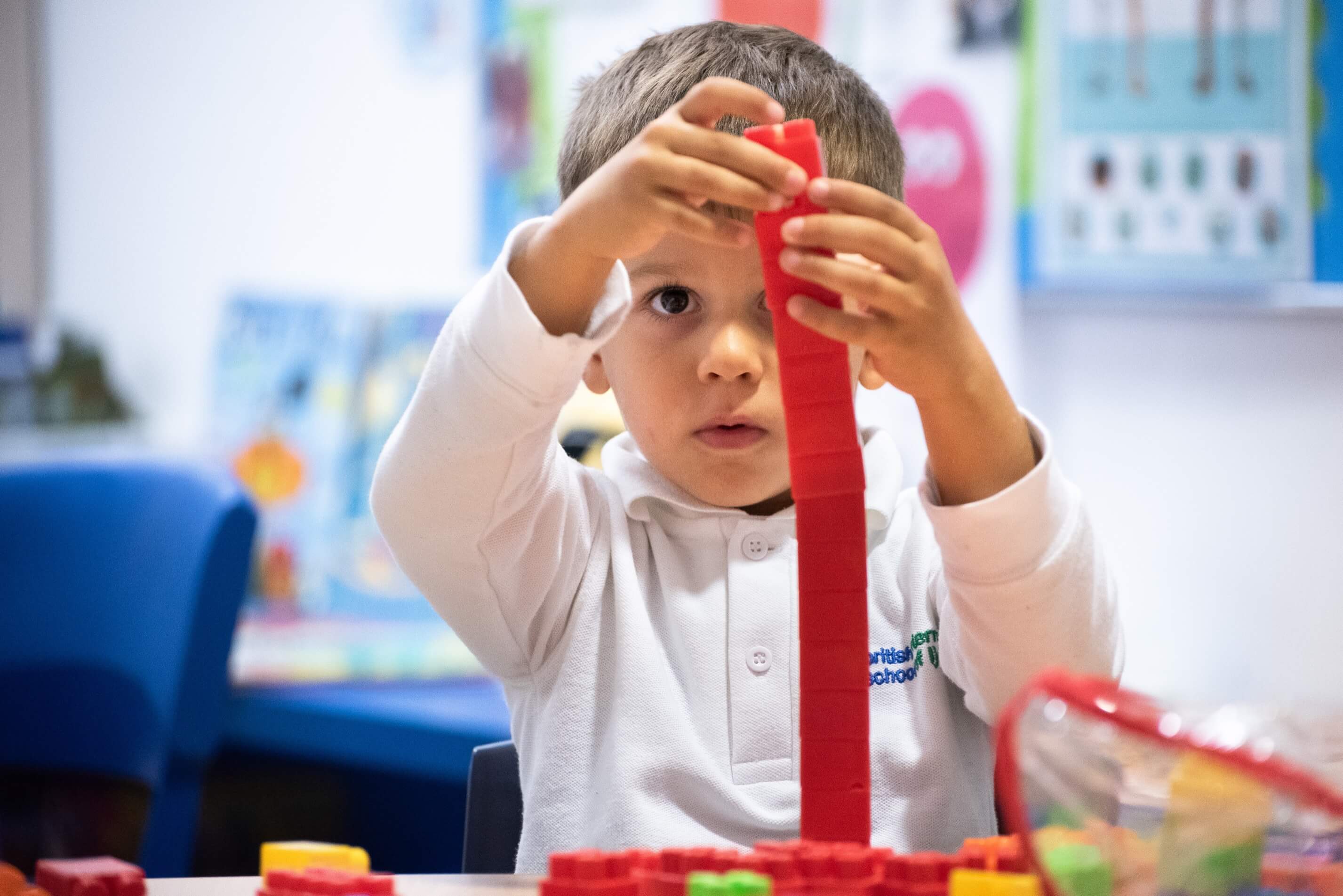
The Principal, Paul Walton, commented, “We have used this time during the summer effectively to produce impressive online courses, excellent training opportunities for our teachers and time to plan together. The way in which they have embraced the challenge to develop curriculum has been inspiring and they have exceeded expectations with their work ethic and effort to create the best resources for students.”
The school again offered a two-week summer school for their students and, with over 80 participants, it was more popular than ever this year. Students thoroughly enjoyed learning together and were full of energy, happy and safe. During the first term, the school have also created opportunities for ‘enrichment days’ that are free for students outside of the normal timetable. The aim is to provide them with further activities that were restricted due to COVID-19, including team sports, practical activities, science experiments and physical education challenges. This will help students gain valuable life skills and experiences with others together in a safe and secure environment.
The British International School of Ljubljana benefits from being part of the Orbital Education Group, where there is a continued focus on offering a provision of high-quality education across all the schools.
Learn more about the British International School of Ljubljana<. And there's a virtual open day planned for Friday, 14 August, with details here
STA, 6 August 2020 - Police have seized 2,650 cannabis plants with an estimated street value of around EUR 2 million in the Lendava area in the north-east in what is the biggest cannabis bust in the Pomurje area in recent years. Three middle-aged men were arrested and face up to ten years in prison.
The plants were grown on an island on the Mura river on a plot measuring 100 X 300 metres. The land has multiple owners, with the biggest being the state, and is just next to the Croatian border.
According to Dejan Ravš, the head of the organised crime unit of the Murska Sobota police department, the bust was made following a tip-off to the Lendava police.
Police occasionally laid in ambush at the site but it was only this Monday morning that three men, aged 40, 45 and 48, appeared at the plantation.
A view from the air of the plantation
All three were arrested and police also confiscated their vehicle.
Since the water level of the Mura is high these days, the cannabis plans were transported from the island by a police helicopter.
The plants were 80-110 centimetres high and could be used to produce at least 600 kilogrammes of high quality marijuana with an estimated street value of around EUR 2 million.
They will be dried and used as evidence before being destroyed. The suspects face from one to ten years in prison.
According to Ravš, this is the biggest cannabis bust in the Pomurje area in recent years. This year, five illegal marijuana growing operations were discovered along with two indoor growing facilities.
STA, 6 August 2020 - One in two 29-year-old Slovenians was living with their parents in 2018, whereas in 1991, the year Slovenia gained independence, only 20% of youths had such live-at-home arrangements. In 2018, most young people worked as service or sales workers, with some 80% of those aged 29 having a job.
At the beginning of 2020, there were some 310,000 youths in Slovenia, aged between 15 and 29, which compares to 430,000 in 1991, show the Statistics Office data released prior to International Youth Day, observed on 12 August.
According to recent projections, the number of youths will drop to the lowest level after 2080, when the figure is projected to stand at roughly 280,000. The downward trend will thus soften compared to the decrease seen among young population since independence.
When it comes to young people in Slovenia and their professions, two factors stood out in 2018: they seemed to be less interested in farming - the number of young farmers was down by 31% on the average, and a relatively small share of youths were managers or occupied top positions in the public administration compared to the average across all professions.
Out of the generation which was aged 22 in 2011, more than 90% remained in Slovenia seven years later. More than half of those who had emigrated were students in 2011. Most of the emigrants, aged 22 in 2011, live in Austria, Germany, Switzerland and Bosnia-Herzegovina now.
Taking a look at the financial position of those aged 29 in 2018, the data shows that the median annual gross income for those employed that year was near EUR 16,150, for the unemployed EUR 6,400, for students EUR 5,200 and for other inactive persons EUR 5,800.
The median annual gross income of 29-year-olds, including taxable and non-taxable income, in 2018 was EUR 14,800, which compares to EUR 15,700 for 34-year-olds. The median gross income for the 24-year-olds was meanwhile EUR 9,200. Fewer than half of those aged 24 in 2018 were employed.
29-year-old Slovenians with tertiary education exceeded the average income of those with secondary education by almost 30% in 2018.
International Youth Day was declared by the UN in 1999 to raise awareness about youth issues and stress the role young people have in society. The theme of 2020 International Youth Day focuses on the ways the young engage at local, national and global levels to contribute to institutional politics.
STA, 5 August 2020 - Led by Ljubljana, where the average price of a used flat rose by 40% to EUR 2,800 per square metre between 2014 and 2019, Slovenia has seen one of the fastest housing price growth rates in Europe in recent years. The Ljubljana Public Housing Fund (Javni stanovanjski sklad Mestne občine Ljubljana) is hoping to ease the pressure with some 240 new subsidised rental units in the coming two years.
The fund announced that 174 flats being built at Brdo on the western edges of the capital are in the final stage of construction, while work has also started on 156 units emerging as part of the Rakova Jelša II project in the south of the city. The target year for completion is 2022.
Moreover, next year is planned to see the start of construction for Jesihov štradon, a housing estate south-east of the city centre that will have 44 units, and the Litijska Pesarska project in the eastern part of Ljubljana, which will feature 95 non-profit rental flats.
Additional relief is meant to come with the help of 88 flats in the eastern borough of Zelena jama. The fund said it is in the final stages of the talks for the project and hopes to start with construction this year already.
While data by the Surveying and Mapping Authority suggested that housing prices growth in Ljubljana came to a halt already before the coronacrisis, data by the Statistics Office showed the prices of used flats were still up in the first half of the year by 4.7% year-on-year and by 1% compared to the last quarter of 2019.
According to OECD data, housing prices in Slovenia rose by 24% between 2015 and 2019, which compares to a eurozone average of 14%.
Meanwhile, efforts addressing the lack of supply in the capital amid favourable loans have also come from private investors, a large portion of whose projects has however also been targetting the well-heeled.
Recent examples include the emerging Schellenburg project at the site of Kolizej, an Austro-Hungarian-era army housing complex that was pulled down in 2011, and the Šumi project opposite the Drama theatre.
Major residential tower projects are also in the making, in particular in the northwestern borough Šiška. Slovak developer Corwin announced just today that construction work has begun on its EUR 45 million Kvartet project that involves four 15-storey towers with a total of 221 flats.
A similar project, estimated at EUR 40 million and featuring two 21-storey buildings with around 220 apartments in total, was announced for Šiška last year by Spektra Invest, which is connected to businessman Izet Rastoder and Zetagradnja, the biggest investor and builder in Montentegro.
A follow-up story to our interview with Margaret Walker about her novel His Most Italian City.
By what convoluted route did an Australian come to write an historical novel about Slovenian Trieste? It’s a long story.
Asking my birth mother Silvana (1920-2020) for her family history was like getting blood out of a stone and, when at last she began to reminisce about her earliest days in Istria at the age of 90, it was a race against time to record it. Nevertheless, I discovered that her father came from Trieste and her maternal grandmother, Marija Matiasić, had run away from a village in Slovenia aged 16 sometime in the 1870’s. I began to write His Most Italian City so that these memoirs might not be lost, in the process uncovering the history of Slovenian Trieste that ran parallel to it.
In common with Sydney, where I come from, ports are multicultural places and in my novel I have drawn Trieste this way. It is a city perched at the crossroads of Slav, Latin and Germanic peoples and, before World War One, served as the port of Vienna. Half its population spoke a dialect of Venetian, like my mother, and the Slovenes, who made up one quarter, were the largest ethnic minority. When I wrote on page 117 of the novel that ‘half his friends came from mixed marriages,’ you can easily see this ethnic diversity in the nineteenth century marriage records of Trieste.
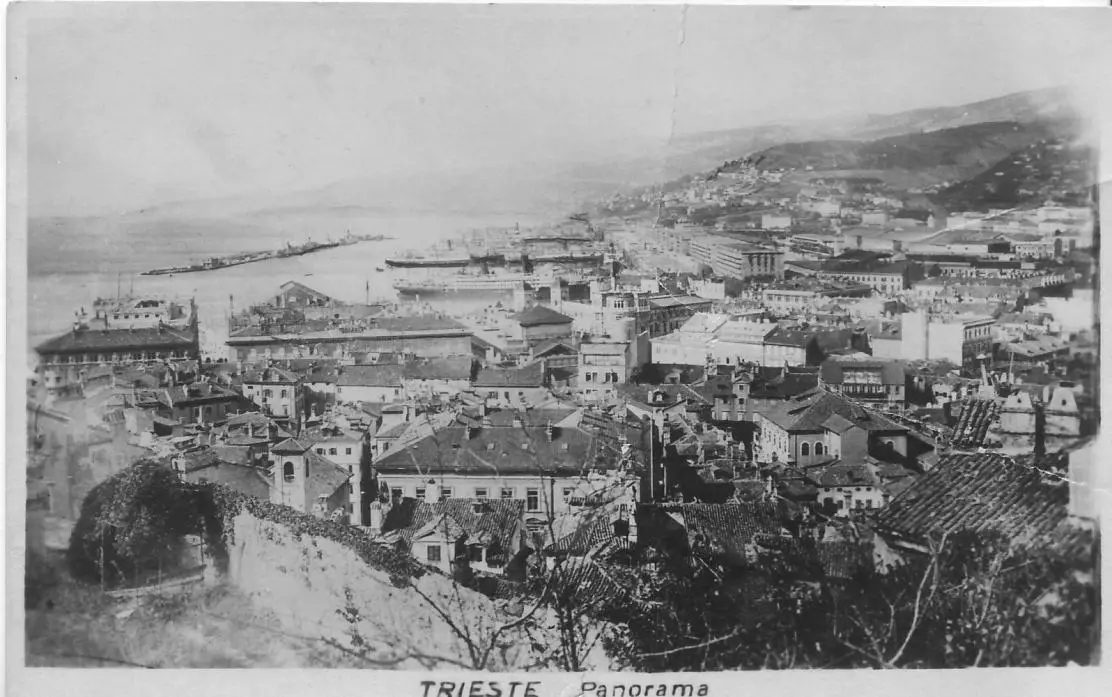
Trieste in 1919. Wikimedia
“Repressed by Austria no more! Viva l’Italia!” page 65. Austrian tolerance of multiculturalism was a threat to an Italy only recently united, and deeply resented by its intellectuals and politicians who had been the driving forces of the Risorgimento. Declaring themselves the inheritors of Ancient Rome, they envisaged an Italian Empire, and developed a movement involving land claims where Italian ethnic or language groups lived, called ‘irredentism’. Its definition varied from reasonable to extreme. For example, in the novel my Istrian grandmother Dolores is half Slovenian and half Croatian, speaks Venetian but considers herself Italian. If a town contained enough people like her (or even if it didn’t) an irredentist might claim that the town was Italian. For the Slovenes in Trieste the movement signified that irredentists considered Austrian Trieste to be ‘unredeemed Italy’.
Piazza Oberdan by Boris Pahor begins by chronicling the growth of the irredentist movement in Trieste and its effects on the Slovenian population. The book is the collected memoirs and stories of a particular place at a particular time by an author who was frequently an eye witness. It is essential reading for anyone who is interested in Slovenian Trieste. Unfortunately, I could only find it in German and Slovenian. (Translators, please note: when can we expect an English edition?)
The irredentist movement became particularly significant in Trieste after 1870 with the Italian occupation of Rome and the Vatican. The Irredentists so strongly influenced public opinion that gradually the citizens began to give way to it… This was not in harmony with the Slovene population….The irredentists, therefore, turned their attention to the Slovene middle class and often provoked clashes between Trieste citizens of Slovenian descent and Italian agitators.
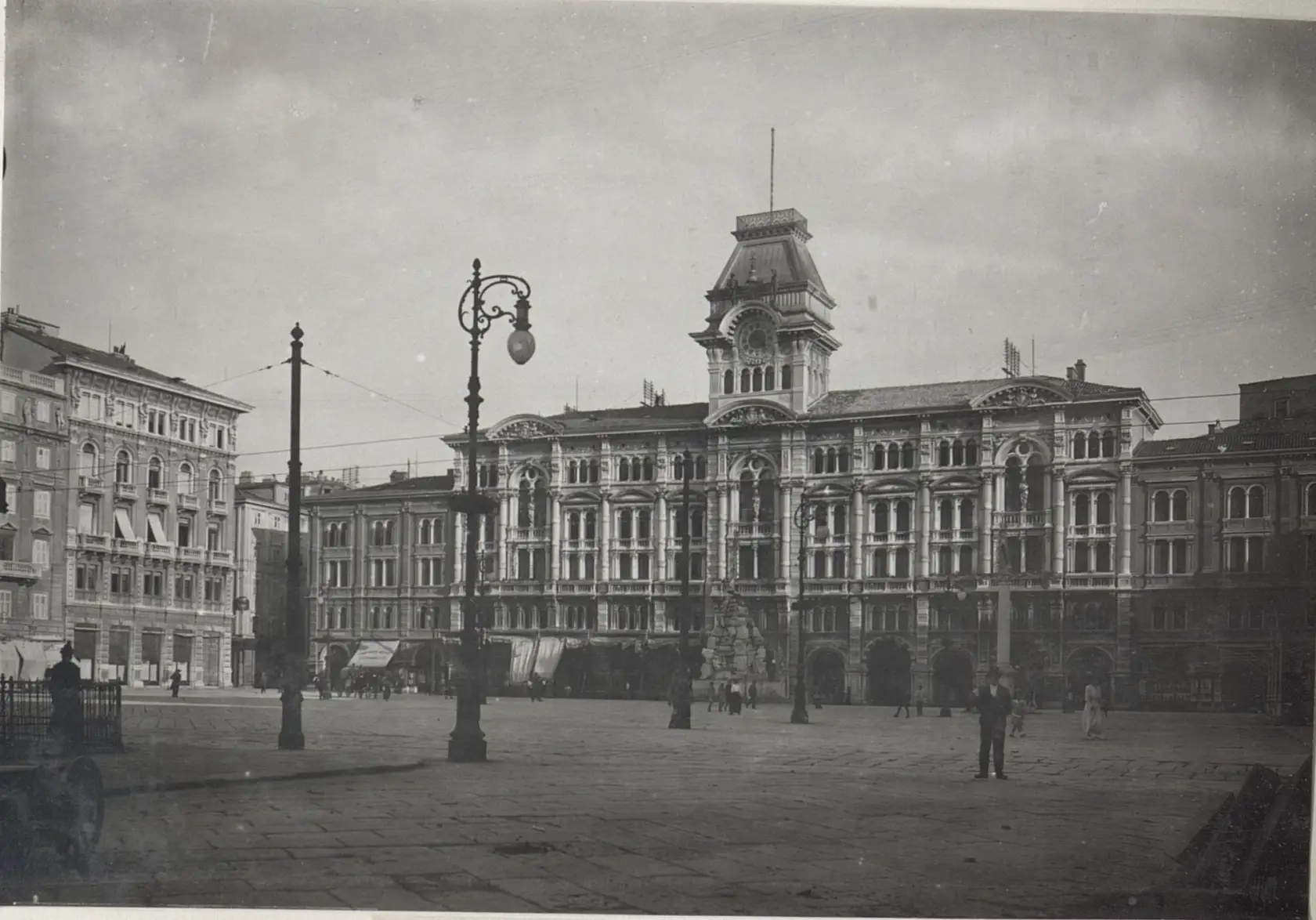
Apart from the fact that they wanted to shake off German dominance, the Italian nationalists had an additional motive for connecting the city to Italy: resistance to the economic and cultural growth of the Slovenian people, a population that had been an integral part of the city for twelve centuries. It consisted of peasants in the suburbs, but in the city itself it consisted of carters, waterside workers, cooks, nurses, masons, labourers, and small merchants…In 1848, as in Vienna, so in Trieste, people demanded the recognition of their Slovenian identity, and so gradually began to form a Slovenian middle class.
The construction of the Narodni Dom in 1904 was, according to Pahor, a great provocation to the anti-Slovenian Italian agitators, accustomed to seeing the Slovene community composed of small karst farmers, dairy maids, housewives and labourers. When, after the end of the war, Rome seized control of the city and its surroundings, the Narodni Dom became one of the main targets of the hate that had hitherto been suppressed.
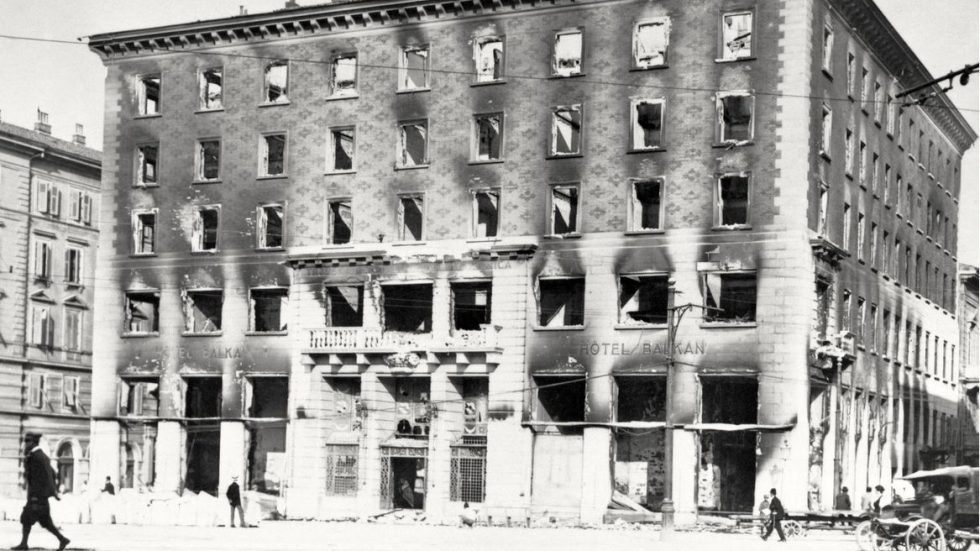
The burned out hall. Wikimedia
Pahor then records its destruction:
On that afternoon of July 13, 1920, the sky had turned blood red before sunset, and at the same time we learned of the fire… we ran downhill in the direction of those dull voices that came up from the piazza. We were actually witnesses of the events when we stopped at the corner in front of the coffee house Fabris. Everything in front of us was as if it were on a stage: that screaming crowd, over which the flames were zipping out of the windows of the Narodni Dom. We were shocked, held each other's hands, and stared at the firefighters. The attackers refused to allow them to direct their streams of water at the burning building… I probably wondered, as was the case later, why this fire, what was this crowd, this assault on the fire hoses, so that the water did not shoot up but poured itself on the ground? I learned later that people from within the Narodni Dom had doused it with petrol from the barracks, and that two people had jumped out of a hotel room onto the street.
In what has been termed ‘Trieste’s Kristallnacht’, a great deal of other Slovenian property in the city was also attacked.
Pahor continues, “As the editor of the newspaper Il Piccolo, Rino Alessi, put it in his article ‘Trieste has placed itself at the head of fascism.’” He goes on to detail the violence towards the Slovenian community in Trieste and in the Slovenian territory given to Italy after World War One.
In order to record a balanced judgement, it’s important to put this historical period into context. Fuelled by misinterpreted Darwinism, racism was in vogue not only in Germany and Italy, but even in Britain. This meant that, in response to Italian demands at the secret Treaty of London, which in 1915 brought Italy into the war, Britain had few qualms about incorporating one third of small Slavic Slovenia into an enormous Italy already on the brink of Fascism. After the war, the single voice for the national self-determination of the Slavs was US President Woodrow Wilson who addressed this issue in his Fourteen Point Plan. Unfortunately his suggestions were ignored and Mussolini, who was soon to take power, was a vocal anti-Slav racist. What followed were the ravages of Fascism as it stretched its tentacles far and wide.
The best referenced article I have read about this time was written by Gianfranco Cresciani. ‘A clash of civilizations? The Slovene and Italian minorities and the problem of Trieste.’ Italian Historical Society, Australia. Volume 12, No. 2 July-December 2004.
Dr Cresciani writes that within Trieste and Istria the Fascist regime “progressively shut down most Slovene or Croat institutions. Between 1918 and 1928, 488 primary schools were closed, as well as some 400 cultural, sporting, youth, social and professional organizations and libraries, three political parties, 31 newspapers and journals, and 300 co-operatives and financial institutions.”
One day when Silvana, my birth mother, was 97, we were out for a walk when suddenly she said, “My father was very unhappy. The government wanted to move him all over Italy.” This was Romano Tonon (1886 -1956), born in Trieste to an Italian mother and Venetian father, but apparently limited in his career choices because he was educated in Graz rather than Italy.
On page 138 of the novel, my great uncle (1896 – 1984), who was Slovenian and Croatian and also educated in Austria, was denied promotion at the University of Florence. Silvana deplored the discrimination he suffered. She mentioned it on many occasions. I have a photograph of Zio Lin, as she called him, still lecturing about a mosquito that attacked olives at retirement age. In 1928 his family’s name was Italianised. The original Italian in the birth register reads: ‘Il controscritto cognome di Micatovich è stato corretto a quello di Di Micheli con decreto del Prefetto di Pola.’ ‘The countersigned surname Micatovich has been corrected to that of Di Micheli with the decree of the Prefect of Pola’. In the same register a further round of Italianising Slavic names occurred in 1933.
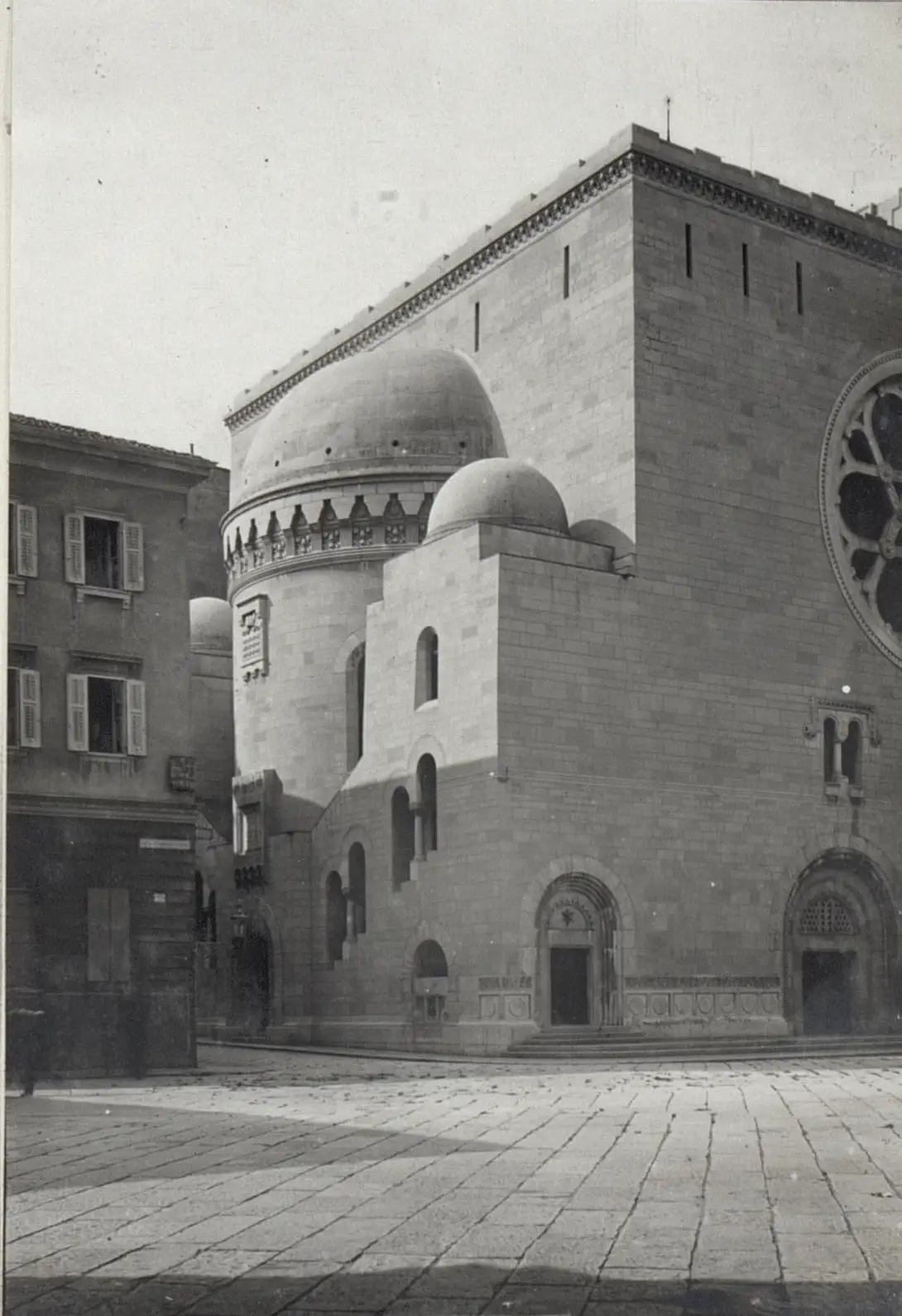
Synagogue in Trieste. Wikimedia
I believe that any article about Slovenian Trieste needs a reference to Britain. There are several of these in my novel. “Britain, in particular, will back Italy as harmless if it serves British interests” – page 24. “Istria was given to Italy after the war by the winners because the Italians asked for it, and to reward it for fighting on their side” - page 174.
In 1923 King George V “conferred upon Mussolini the insignia of the Order of the Bath and congratulated the country for emerging from its recent crisis ‘under the wise leadership of a strong man of government’”. (Fascist Voices by Christopher Duggan, Vintage 2012.) And according to my father-in-law, who was an Australian soldier in Italy between 1942 and 1945, it was fear of the communism of the Italian Partisans (not Yugoslav) that led Britain to approve of General Badoglio as Prime Minister following Mussolini because, despite his Fascist war crimes, he was anti-communist. Douglas Walker received the Certificato al Patriota for his work with the Italian Partisans, but he continually stressed the importance to the Allies of stabilizing Italy.
Lastly,Trieste Goes to Australia by Gianfranco Cresciani (Padana Press, 2011) documents the fate of so many Slovenians in Trieste when the city was returned to Italy in 1954 after nearly a decade of being a freeport under Allied occupation. Particularly poignant are the photographs of the Audace Pier crowded with thousands of forced emigrants, ten percent of Trieste’s population. After their departure, depression fell upon the city.
Today is a time for understanding and healing between these two nations. Italy has thirty times the population of Slovenia, and at least that number again living around the world claim Italian heritage. We are far enough removed from Mussolini for these Italians who may not know of his excesses to study them objectively. So my last words will come from an Italian: “To be ignorant of what occurred before you were born is to remain forever a child.” – Cicero.
You can learn more about Margaret Walker's work here
STA, 4 August 2020 - Alcohol consumption among young people in Slovenia declined in 2017/2018 but it remains high by international standards, the National Institute for Public Health (NIJZ) said on Tuesday, as it presented the results of international survey Health Behaviour in School-aged Children (HBSC) for Slovenia.
The survey, conducted in Slovenia every four years, showed that 71% of 15-year-olds and 86% of 17-year-olds have tried alcohol, while 27% of 15-year-olds and 52% of 17-year-olds have been drunk at least twice in their life.
Do you drink too much? Take a simple test in relatively simple Slovene at sopa.si
"The trends in the 2002-2018 period are favourable; most indicators of alcohol consumption are down, but we are still exceeding the international HBSC average," said the head of the project in Slovenia, said Helena Jeriček Klanšček from the NIJZ.
Slovenia ranks 11th among the 45 countries included in the survey in terms of the share of 15-year-olds who have been drunk at least twice in their life and 10th by the share of those who have tried alcohol, Jeriček Klanšček said.
The NIJZ stressed that parents' attitude to alcohol and communication with their children was crucial in preventing alcohol abuse.
You can see a PDF of the full WHO report, which covers much more than alcohol, here
STA, 31 July 2020 - On 1 April, Slovenia had a total of 2,097,195 residents, which is 12,894 or 0.6% more than on the same date last year, show data from the Statistics Office (SURS). In the first quarter of the year, the number of Slovenian citizens fell, while the number of foreigners residing in Slovenia increased.
In the first quarter, the number of residents was up by 1,334 year-on-year, but the number of Slovenian citizens decreased by 1,900 or 0.1%.
On the other hand, the number of foreign citizens residing in Slovenia was up by 3,200 or 2.1% to 159,582, which represented 7.6% of Slovenia's total population.
At the beginning of April, there were 1,052,649 men and 1,044,546 women residing in Slovenia, but the share of women among Slovenian citizens alone was 51.2%. The SURS has noted that this share has been slowly declining for years.
Among the foreign citizens residing in Slovenia, women represented only 33.4%. After growing for several years, this share has been down since the beginning of 2018 by 1.9 percentage points.
In the first quarter of 2020, immigration to Slovenia was down by 2% compared to the same period last year.
While 7,622 persons moved to Slovenia in the first quarter, 4,941 moved out of Slovenia, which is 66% more than in the same period in 2019.
Slovenian citizens who moved out of the country (1,599) represented around 50% of the number of foreign citizens who left Slovenia in this period (3,342).
According to SURS, a total of 4,364 births were recorded in Slovenia in the first quarter, while 5,711 residents died, which is 201 and 269 fewer compared to the same period last year, respectively.
In the last year, the rate of natural increase, the difference between the number of births and deaths per 1,000 residents, changed from -2.8 to -2.6.
All our stories on demographics and Slovenia
STA, 31 July 2020 - The Islamic community in Slovenia will celebrate this year's Eid al-Adha, a major Muslim holiday, somewhat differently due to the restrictive anti-epidemic measures, as believers are coming to the new Muslim Cultural Centre in Ljubljana on Friday in groups of 50 in four separate ceremonies.
Also called Eid Qurban or Bakra-Eid, the Feast of the Sacrifice is considered the holier of the two major Muslim holidays, honouring the willingness of Ibrahim (Abraham) to sacrifice his son Ismael as an act of obedience to God's command.
It is also connected with the annual pilgrimage to Mecca, Saudi Arabia, called Hajj, but this year Slovenian Muslims have not travelled to the holiest city in Islam due to the Covid-19 pandemic.
The Islamic community in Slovenia said on the occasion that Eid al-Adha is the time when people think about their families, relatives and friends and about how they feel.
"Hajj is a symbol of unity and deep belief, but also of diversity among people. It teaches them that everything is passable on Earth and that ethical and moral values are key for harmonious mutual relations," it added.
The community has recommended Slovenian Muslims focus on their families in the four days of celebration of Eid al-Adha, and advised against mass gatherings so that the unnecessary spread of the novel coronavirus is prevented.
"In their prayers, they should remember those who have found themselves in a difficult situation due to the epidemic. They should also think about healthcare workers, who are the most exposed to the virus and make the most sacrifices."
The first ever Eid al-Adha ceremony in the Ljubljana mosque was addressed by Mufti Nedžad Grabus, who pointed to the values of human life and equality, but could not avoid talking about the conditions dictated by the pandemic.
"The circumstances we live in demand full responsibility from all of us," said Grabus.
Nevzet Porić, the secretary general of the Islamic community in Slovenia, told the STA that, due to the restrictions, the ceremony had been attended by some 200 people, considerably less than in past years (up to 4,000).
"It's Eid al-Adha, but the feeling is strange, because you cannot shake hands with your friends and embrace them," he added, while calling on the community to be responsible as a few of its members already had died of Covid-19.
Grabus added that this year's prayers were also focused on "god easing the situation related to the contagious disease, which the entire world is fighting with, to protect the community from illness, worries and temptation."


